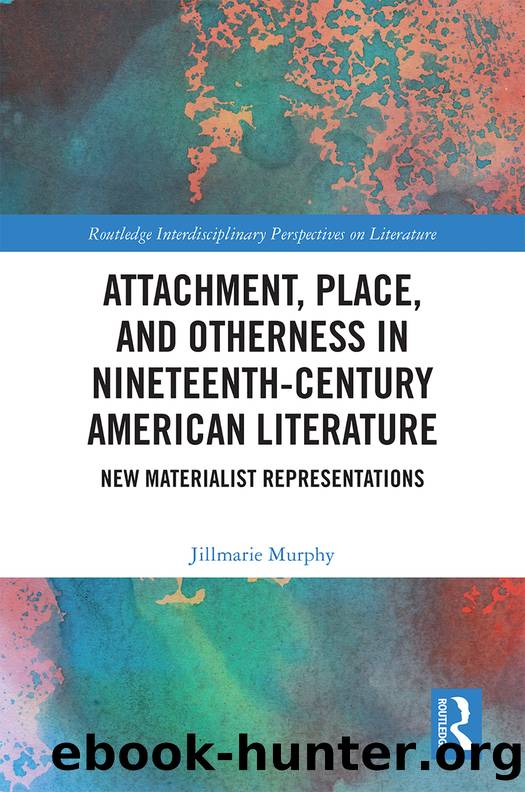Attachment, Place, and Otherness in Nineteenth-Century American Literature by Jillmarie Murphy

Author:Jillmarie Murphy
Language: eng
Format: epub
Publisher: Taylor & Francis (CAM)
Published: 2018-08-15T00:00:00+00:00
With Quaker City, Lippard chose to fictionalize a society he regarded as lurid and terrifying, and thus, as Reynolds contends, he succeeded in creating a ânightmare worldâ that was always âthreatening to destroy ordinary perceptions of objective surroundings.â30 Likewise, by setting Arthur Mervyn during the height of the worst yellow fever epidemic in Philadelphia history, Brown successfully fashions a similarly nightmarish world in which disease is emblematic of societal corruption. While Lippard candidly exploits the sensational in Quaker City, where the major playersâMary Arlington, Long-haired Bess, Gus Lorrimer, Byrnewood Arlington, Devil-Bug, and Mother Nancyâare surreal and/or grotesque caricatures of real people, in Arthur Mervyn, Brown compels the main character to confront grotesquery as a way to find his own truth in a diseased society, where surreal events repeatedly challenge his perceptions of reality. Although Lippard was âpilloriedâ by many of his contemporaries, who were horrified by his uncensored attacks on âevery type of ârespectableâ Philadelphian,â he increasingly rose in favor among those who saw him as a âchampion of the poor and a foe of the hypocritical elite.â31 Lippardâs candor and unrestrained passion in Quaker City are, like Brownâs in Arthur Mervyn, palpable illustrations of his defense of the oppressed.
The essay âThe Heart-Broken,â which is Lippardâs tribute to Charles Brockden Brown, suggests Lippard felt more than professional admiration for Brown. Writing of Brownâs final resting place in a âQuaker graveyard,â32 whose âgreen mounds extend from the door of the meeting-house to the walls,â Lippard declares that Brownâs grave holds a âsad and peculiar interestâ for him. Beneath that âclump of sod,â he writes, lies a âstrong Heart, throbbing with impulses that were breathed into it by Almighty God⦠and a skull that once flashed with divine fire from the eyes, and worked immortal thoughts within its brain.â For Lippard, Brown was a âGreat Soul, worthy to stand in solemn dignity among the mightiest names of earth.â Describing Brown in a way that could just as readily be a description of himself, Lippard writes of Brown having a âsupernatural analysis of motive and character, a superhuman POWER in Genius.â33
Throughout their lives, both Brown and Lippard tethered their humanitarian impulses to their social and intellectual pursuits. In the late 1790s, Brown joined The Friendly Club, a group comprised of young professionals who sought intellectual companionship with likeminded others. Members of The Friendly Club included women, many who were friends or relatives of male members. The groupâs focus on rational ideals and egalitarian models of companionship undoubtedly influenced Brownâs surge of writing during the late 1790s, which included not only Arthur Mervyn, a novel Lippard described as containing a âtouching pathos or thrilling powerâ that âimmeasurably excels the works of De Foe or Boccaccio,â but also the novel Wieland; or The Transformation (1798), which Lippard thought of as âa tremendous book, awful in its delineations of a stern and unrelenting Fanaticism,â in which the female narratorâs rational intellect is juxtaposed with her brotherâs progressive insanity; and Ormond; or The Secret Witness (1799), a novel in which Brown explores cross-dressing, same-sex companionship, and the trauma of rape.
Download
This site does not store any files on its server. We only index and link to content provided by other sites. Please contact the content providers to delete copyright contents if any and email us, we'll remove relevant links or contents immediately.
The Tidewater Tales by John Barth(12391)
Kathy Andrews Collection by Kathy Andrews(11322)
Tell Tale: Stories by Jeffrey Archer(8678)
This Is How You Lose Her by Junot Diaz(6434)
The Mistress Wife by Lynne Graham(6241)
The Last Wish (The Witcher Book 1) by Andrzej Sapkowski(5212)
Dancing After Hours by Andre Dubus(5113)
The Sympathizer by Viet Thanh Nguyen(4093)
Maps In A Mirror by Orson Scott Card(3718)
The Secret Wife by Lynne Graham(3660)
Be in a Treehouse by Pete Nelson(3646)
Tangled by Emma Chase(3566)
Ficciones by Jorge Luis Borges(3364)
The House on Mango Street by Sandra Cisneros(3226)
Girls Who Bite by Delilah Devlin(3044)
A Knight of the Seven Kingdoms by George R R Martin(3026)
You Lost Him at Hello by Jess McCann(2858)
MatchUp by Lee Child(2691)
Once Upon a Wedding by Kait Nolan(2609)
